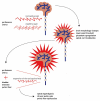Pathogenesis of Endometriosis: The Origin of Pain and Subfertility
- PMID: 34205040
- PMCID: PMC8226491
- DOI: 10.3390/cells10061381
Pathogenesis of Endometriosis: The Origin of Pain and Subfertility
Abstract
Endometriosis (EM) and adenomyosis (AM) are common conditions with pain and infertility as the principal symptoms. The pathophysiology of pain in EM and AM comprises sensory and somatoform pain mechanisms. Over time, these may aggravate and lead to individual complex disease patterns if not diagnosed and treated. Despite the known facts, several years often pass between the onset of symptoms and diagnosis. Chronic pain disorders with changes on a neuronal level frequently arise and are linked to depressive disorders, with the process becoming a vicious cycle. Additionally, women with EM and AM suffer from sub- and infertility. Low fecundity rates are caused by anatomical changes in combination with behavioral changes in the sexual activity of women with chronic pain as well as local proinflammatory factors that not only decrease implantation rates but also promote early abortions.
Keywords: adenomyosis; endometriosis; infertility; inflammation; ovarian reserve; pain; pathophysiology.
Conflict of interest statement
The authors declare no conflict of interest.
Figures


References
-
- Porpora M.G., Scaramuzzino S., Sangiuliano C., Piacenti I., Bonanni V., Piccioni M.G., Ostuni R., Masciullo L., Benedetti Panici P.L. High prevalence of autoimmune diseases in women with endometriosis: A case-control study. Gynecol. Endocrinol. 2020;36:356–359. doi: 10.1080/09513590.2019.1655727. - DOI - PubMed
Publication types
MeSH terms
LinkOut - more resources
Full Text Sources
Medical

